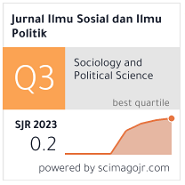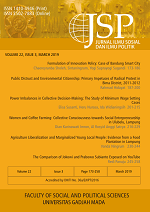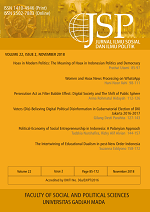Contested Access in the Failing Urban Culinary Tourism Planning: A Case of Bogor, Indonesia
Agustina Multi Purnomo(1*)
(1) Faculty of Social, Politics, and Computer Science, Djuanda University, Indonesia
(*) Corresponding Author
Abstract
This study explores the role of urban tourism planning at the national and regional levels in developing Indonesia’s culinary tourism destinations. Culinary destination tourism planning in Indonesia is under‐researched. This study aims to fill the gaps. Using the spatial triad analysis, this study explores the interrelatedness between the conceived-perceived-lived government planning activities in shaping culinary tourism destinations. Bogor City case was chosen because it has a higher culinary growth rate than other nearby cities. Bogor City analyzed in regional and national context. Based on the observations and the document studies, including text, promotion, publication, and document analysis, the research found that government culinary tourism planning has failed to develop culinary tourist destinations and attractions. The problem lies in the inconsistency between equivalent policies and the discontinuity between policy and implementation. The research findings indicate the governments lack of understanding of the subject matter and planning mechanisms. The culinary tourism planning activities have also created a classical contest of capital power. This research finding suggests the need for a better understanding of culinary tourism attractions and destinations and better planning mechanisms.
Keywords
Full Text:
PDFReferences
Ab Karim, S., & Chi, C. G. Q. (2010). Culinary tourism as a destination attraction: An empirical examination of destinations' food image. Journal of hospitality marketing & management, 19(6), 531-555.
Alonso, A. D., Kok, S., & O’Brien, S. (2018). Sustainable culinary tourism and Cevicherías: a stakeholder and social practice approach. Journal of Sustainable Tourism, 26(5), 812–831.
Amore, A., & Roy, H. (2020). Blending foodscapes and urban touristscapes: International tourism and city marketingin Indian cities. International Journal ofTourism Cities, 6(3), 639-655.
Bogor City Regional Secretary. (2011). Regional regulation number 8 of 2011. https://jdih. kotabogor.go.id/index.php/Home/Home/ katalog/322.
Bogor City Regional Secretary. (2016). Regional regulation number 9 of 2016. Retrieved from https://jdih.kotabogor.go.id/index.php/ Home/Home/katalog/378.
Bogor City Regional Secretary. (2019). Regional regulation number 14 of 2019. Retrieved from https://kotabogor.go.id/uploads/ files/RPJMD 2019‐2024 Kota Bogor.pdf.
Bristow, R. S., & Jenkins, I. (2018). Restaurant assessment of local food and the Global Sustainable Tourism criteria. European Journal of Tourism Research, 18, 120–132.
Bustomi, T., & Avianto, B. N. (2022). City branding of the “music-design-culinary” as urban tourism of Bandung, West Java. International Journal of Tourism Cities, 8(1), 53-69.
Cardno, C. (2018). Policy Document Analysis: A Practical Educational Leadership Tool and a Qualitative Research Method. Educational Administration: Theory & Practice, 24(4), 623–640.
Chiodelli, F. (2013). Planning and urban citizenship: suggestions from the thoughts of Henri Lefebvre. Planning Perspectives, 28(3), 487–494.
Coleman, N. (2013). Utopian Prospect of Henri Lefebvre. Space and Culture, 16(3), 349–363.
de Albuquerque Meneguel, C. R., Mundet, L., & Aulet, S. (2019). The role of a high‐quality restaurant in stimulating the creation and development of gastronomy tourism. International Journal of Hospitality Management, 83, 220–228.
de Jong, A., & Varley, P. (2018). Food tourism and events as tools for social sustainability? Journal of Place Management and Development, 11(3), 277-295.
De Jong, A., & Varley, P. (2017). Food tourism policy: Deconstructing boundaries of taste and class. Tourism Management, 60, 212–222.
De Satgé, R., & Watson, V. (2018). Urban planning in the global south: Conflicting rationalities in contested urban space. Gewerbestrasse: Springer.
Dimitrovski, D., & Crespi Vallbona, M. (2018). Urban food markets in the context of a tourist attraction–La Boqueria market in Barcelona, Spain. Tourism Geographies, 20(3), 397–417.
Dredge, D., & Jenkins, J. (2011). Stories of practice: Tourism policy and planning. Wey Court East: Ashgate Publishing, Ltd.
DTC Bogor City. (2019). Strategic plan 2019-2024. Retrieved from https://disparbud.kotabogor.go.id/asset/images/web/files/ renstra-2019-2024.pdf.
DTC Bogor City. (2020). Working plan 2020. Retrieved from https://disparbud.kotabogor.go.id/asset/images/web/files/renja-2020.pdf.
Du, Y. (2019). Policies and Counterstrategies: State-Sponsored Filiality and False Accusation in Qing China. International Journal of Asian Studies, 16(2), 79–97.
Edgell Sr, D. L., & Swanson, J. R. (2019). Tourism policy and planning: yesterday, today, and tomorrow. New York: Routledge.
Ellis, A., Park, E., Kim, S., & Yeoman, I. (2018). What is food tourism? Tourism Management, 68, 250–263.
Fitriyani, E., Pratiwi, I. I., & Suwandi, A. (2021). Culinary tourism planning and development: A case in Gebang Mekar Cirebon. In A.H.G. Kusumah, C.U. Abdullah, D. Turgarini, M. Ruhimat, O. Ridwanudin, & Y. Yuniawati (Eds.), Promoting Creative T ourism: Current Issues in Tourism Research (pp. 116–122). London: CRC Press. https://doi.org/10.1201/9781003095484.
Fountain, J., Cradock-Henry, N., Buelow, F., & Rennie, H. (2021). Agrifood tourism, rural resilience, and recovery in a post-disaster context: Insights and evidence from Kaikōura‐Hurunui, New Zealand. Tourism Analysis, 26(2–3), 135–149.
Gottdiener, M., Hohle, R., & King, C. (2019). The new urban sociology. New York: Routledge.
Graneheim, U. H., Lindgren, B.‐M., & Lundman, B. (2017). Methodological challenges in qualitative content analysis: A discussion paper. Nurse Education Today, 56, 29–34.
Hajarrahmah, D., & Daniels‐Llanos, M. (2017). Developing Culinary Tourism to Support Local Tourism Development and Preserving Food Heritage in Indonesia. Proceedings of the 6th International Conference of Arte-Polis, 21–30.
Hall, C. M., & Sharples, L. (2003). The consumption of experiences or the experience of consumption? An introduction to the tourism of taste in Food tourism around the world. In C.M. Hall, L. Sharples, R. Mitchell, N. Macionis, & B. Cambourne (Eds.), Development, Management And Markets (pp. 1-24). Oxford: Elsevier Ltd.
Henderson, J. C. (2019). Street food and tourism: A Southeast Asian perspective. In E. Park, S. Kim, & I. Yeoman (Eds.), Food Tourism in Asia (pp. 45–57). Singapore: Springer. https://doi. org/10.1007/978‐981‐13‐3624‐9.
Ingrid, B., & du Rand, G.E. (2021). Culinary mapping: A gastronomic tourism planning tool. In S.K. Dixit (Ed.), The Routledge Handbook of Gastronomic Tourism (pp. 320-334). New York: Routledge.
Joppe, M. (2018). Tourism policy and governance: Quo vadis? Tourism Management Perspectives, 25, 201–204.
Karagiannis, D., & Metaxas, T. (2017). Local Authorities’ contribution on Gastronomy Tourism Development: the case of Ontario, Canada. MPRA Paper No. 79325.
Kušen, E. (2010). A system of tourism attractions. Tourism: An International Interdisciplinary Journal, 58(4), 409–424.
Kušen, E. (2017). Tourism attraction system. In L. Dwyer, R. Tomljenović, & S Čorak (Eds.), Evolution of Destination Planning and Strategy (pp. 119–148). New York: Palgrave Macmillan Cham. https://doi.org/10.1007/978‐3‐319‐42246‐6.
Leary-Owhin, Michael E. (2018). Henri Lefebvre, Planning’s Friend or Implacable Critic? Urban Planning, 3(3), 1–4.
Leary-Owhin, M.E. (2016). Exploring the production of urban space: Differential space in three post-industrial cities. Great Britain: Policy Press.
Lefebvre, H. (1991). Theproductionofspace (D. Nicholson-Smith, Trans.). Cambridge: Basil Blackwell.
Lefebvre, H. (2003). The urban revolution. Minneapolis: The University of Minnesota Press.
Lemy, D. M., Teguh, F., & Pramezwary, A. (2019). Tourism development in Indonesia. In P.L. Pearce & H. Oktadiana (Eds.), Delivering Tourism Intelligence: From analysis to action (pp.91-108). Bingley: Emerald Publishing Limited. https://doi.org/0.1108/S2042‐144320190000011009.
Lidyana, V. (2020). Wisman Habiskan Rp 280 T di RI, Belanja Apa Saja? Detikfinance. https://finance.detik.com/berita‐ekonomi‐ bisnis/d‐5175981/wisman‐habiskan‐rp‐280-t-di-ri-belanja-apa-saja
Lopes, A. P., & Soares, F. (2017). Tourism planning and development: The case of Portugal’s Norte region. Tourism & Management Studies, 13(4), 20–29.
Mackieson, P., Shlonsky, A., & Connolly, M. (2019). Increasing rigor and reducing bias in qualitative research: A document analysis of parliamentary debates using applied thematic analysis. Qualitative Social Work, 18(6), 965-980.
Mahfud, T., Mulyani, Y., Indartono, S., & Setyawati, R. (2018). Community-based tourism development: foodies community strategy to culinary tourism development in Balikpapan-Indonesia. Ottoman: Journal of Tourism and Management Research, 3(2), 274–289.
Manaf, S. (2020). Analysis of Development of Culinary Tourism Management Model in Case StudyEast Luwu District Based On SIG. International Journal of Tourism and Hospitality in Asia Pasific (IJTHAP), 3(1), 1–14.
Ministry of Cultural and Tourism. (2010). Regulation of the minister of cultural and tourism number PM.87/ HK.501/ MKP/2010. Retrieved from https://jdih.kemenparekraf.go.id/katalog‐146‐Peraturan Menteri.
Ministry of State Secretariat. (2009). Law number 10 of 2009. Retrieved from https://jdih. setneg.go.id/viewpdfperaturan/UU Nomor 10 Tahun 2009.pdf.
Ministry of State Secretariat. (2011). Regulation of the government number 50 of 2011. Retrieved from https://jdih.setneg.go.id/viewpdfperaturan/LAMPIRAN I PP 50 Tahun 2011.pdf.
Ministry of State Secretariat. (2014). Law number 23 of 2014. Retrieved from https://jdih. setneg.go.id/viewpdfperaturan/UU Nomor 23 Tahun 2014.pdf.
Ministry of State Secretariat. (2015). Law number 9 of 2015. Retrieved from https:// jdih.setneg.go.id/viewpdfperaturan/UU Nomor 9 Tahun 2015.pdf.
Ministry of State Secretariat. (2019). Law number 15 of 2019. Retrieved from https://jdih. setneg.go.id/viewpdfperaturan/Salinan UU Nomor 15 Tahun 2019.pdf
Ministry of Tourism. (2015). Regulation of the minister of tou rism number 29 of 2015. Retrieved from https://jdih.kemenparekraf.go.id/katalog‐70‐produk‐hukum
Ministry of Tourism. (2016). Regulation of the minister of tourism number KM.109/ UM.001/MP/2016. Retrieved from https:// pariwisata.bantulkab.go.id/filestorage/dokumen/2017/08/KEPMEN PAR No_109 Thn 2016 ttg IKU KEMENPAR.pdf.
Ministry of Tourism. (2018). Regulation of the minister of tourism number 13 of 2018. Retrieved from https://jdih. kemenparekraf.go.id /katalog‐209‐Peraturan Menteri.
Mnguni, E., & Giampiccoli, A. (2019). Proposing a model on the recognition of indigenous food in tourism attraction and beyond. African Journal of Hospitality, Tourism and Leisure, 8(3), 1–13.
MTCE. (2012). Regulation of the minister of tourism and creative economy number PM.35/UM.001/ MPEK/2012. Retrieved from https:// jdih.kemenparekraf.go.id/asset/data_ puu/regulation_subject_1576737511_ pm35um001mpek2012.pdf.
MTCE. (2020). Regulation of the minister of tourism and creative economy number 12 of 2020. Retrieved from https://jdih.kemenparekraf.go.id/asset/data_ puu/2020PMParekraf012.pdf.
MTCE. (2021). 20 Destinasi wisata kuliner di Indonesia. Kemenparekraf. Retrieved from https://www.kemenparekraf.go.id/ ragam‐ekonomi‐kreatif/20‐Destinasi‐ Wisata‐Kuliner‐di‐Indonesia
Nkooe, E. S. (2018). A Lefebvrian analysis of public spaces in Mangaung, South Africa. Urban Planning, 3(3), 26-39.
Nunes, R. (2017). Rethinking justice in city- regional food systems planning. Built Environment, 43(3), 447–459.
Pilato, M., Platania, M., & Séraphin, H. (2021). Connecting Locals and Visitors: The Case of Street Food. In F. Grasso & B.S. Sergi (Eds.), Tourism in the Mediterranean Sea (pp. 257-277). Bingley: Emerald Publishing Limited.
Privitera, D., Nedelcu, A., & Nicula, V. (2018). Gastronomic and food tourism as an economic local resource: Case studies from Romania and Italy. GeoJournal of Tourism and Geosites, 21(1), 143–157.
Purnomo, A.M. (2020). Produksi ruang wisata kuliner di Kota Bogor: Antara produksi, konsumsi dan lokalitas. Universitas Indonesia. Retrieved from https://lib.ui.ac.id/detail?id=20517469&lokasi=lokal.
Purnomo, A.M. (2021). Development of Local Food in Tourism for Supporting Sustainable Indonesia Tourism Development. In T.N. Mursitama, L.M. Arnakim, J. Abraham, & A.R. Tirtawinata (Eds.), Proceedings of the 3rd International Conference on Social Sciences, Laws, Arts and Humanities (pp. 104–109). Scitepress Digital Library. https://doi.org/10.5220/0000138000002917.
Purnomo, A.M. (2021). Urbanization and Tourism Development in Bogor City. Society, 9(1), 393–409.
Regional Planning Agency. (2020). Final report of RSP Bogor City. Unpub document.
Regional Revenue Agency of Bogor City. (2020). Culinary business tax payer data. Unpub document.
Scheyvens, R., & Laeis, G. (2019). Linkages between tourist resorts, local food production and the sustainable development goals. Tourism Geographies, 23(4), 1–23.
Schreier, M. (2012). Qualitative content analysis in practice. London: Sage publications.
Sharifi, A., & Khavarian‐Garmsir, A. R. (2020). The COVID-19 pandemic: Impacts on cities and major lessons for urban planning, design, and management. Science of The Total Environment, 142391.
Soja, E. W. (2010). Seeking Spatial Justice. Minneapolis: The University of Minnesota Press.
Sotiriadis, M.D. (2015). Culinary tourism assets and events: suggesting a strategic planning tool. International Journal of Contemporary Hospitality Management, 27(6), 1214-1232.
Stoffelen, A., & Vanneste, D. (2016). Institutional (dis) integration and regional development implications of whisky tourism in Speyside, Scotland. Scandinavian Journal of Hospitality and Tourism, 16(1), 42–60.
Thurnell-Read, T. (2012). Tourism place and space: British stag tourism in Poland. Annals of Tourism Research, 39(2), 801–819.
UNWTO & Basque Culinary Center (2019). Guidelines for the development of gastronomy tourism. Madrid: United Nations World Tourism Organization.
Vázquez Blázquez, L. (2018). Latin American Is the New Gourmet: Changes in the Urban Culinary Landscape of Madrid. Anthropology Now, 10(2), 69–77.
Wardana, A. (2019). Contemporary Bali: Contested space and governance. Springer.
Wardani, I. W., Wijaya, D. A., & Saeroji, A. (2018). Culinary Tourism Development Model in Surakarta, Indonesia. KnE Social Sciences, 342–359.
Zieleniec, A. (2018). Lefebvre’s politics of space: Planning the urban as oeuvre. Urban Planning, 3(3), 5–15.
Article Metrics
Refbacks
- There are currently no refbacks.
Copyright (c) 2023 Jurnal Ilmu Sosial dan Ilmu Politik

This work is licensed under a Creative Commons Attribution-ShareAlike 4.0 International License.






















